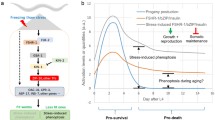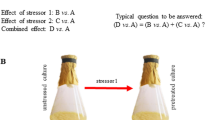Abstract
An integrative perspective on molecular mechanisms of stress resistance requires understanding of these mechanisms not just in vitro or in the model organism in the research laboratory — but in the healthy or diseased human in society, in the cultivated plant or animal in agricultural production, and in populations and species in natural communities and ecosystems. Such understanding involves careful attention to the context in which the organism normally undergoes stress, and appreciation that biological phenomena occur at diverse levels of organization (from molecule to ecosystem). Surprisingly, three issues fundamental to achieving an integrative perspective are presently unresolved: (i) Is variation in lower-level traits (nucleotide sequences, genes, gene products) seldom, commonly, or always consequential for stress resistance? (ii) Does environmental stress reduce or enhance genetic variation, which is the raw material of evolution? (iii) Is the present distribution of organisms along natural gradients of stress largely the result of organisms living where they can, or is adaptive evolution generally sufficient to overcome stress? Effective collaboration among disciplinary specialists and meta-analysis may be helpful in resolving these issues.
Similar content being viewed by others
References
Ackerly D D 2003 Community assembly, niche conservatism, and adaptive evolution in changing environments; Int. J. Plant Sci. 164 S165–S184
Alleaume-Benharira M, Pen I R and Ronce O 2006 Geographical patterns of adaptation within a species’ range: interactions between drift and gene flow; J. Evol. Biol. 19 203–215
Ashburner M 2006 Won for all: how the Drosophila genome was sequenced (Cold Spring Harbor, NY: Cold Spring Harbor Laboratory Press)
Barabâasi A-L 2003 Linked: how everything is connected to everything else and what it means for business, science, and everyday life (New York: Plume)
Bartholomew G A 1964 The roles of physiology and behaviour in the maintenance of homeostasis in the desert environment; in Homeostasis and feedback mechanisms (ed.) G M Hughes (Cambridge: Cambridge University Press) pp 7–29
Bartholomew G A 1987 Interspecific comparison as a tool for ecological physiologists; in New directions in ecological physiology (eds) M E Feder, A F Bennett, W W Burggren and R B Huey (Cambridge: Cambridge University Press) pp 11–35
Bellman R 1961 Adaptive control processes: a guided tour (Princeton: Princeton University Press)
Blows M W and Hoffmann A A 2005 A reassessment of genetic limits to evolutionary change; Ecology 86 1371–1384
Bradshaw A D 1991 The Croonian Lecture, 1991 — Genostasis and the limits to evolution; Philos. Trans. R. Soc. London 333 289–305
Bradshaw W E and Holzapfel C M 2006 Climate change — Evolutionary response to rapid climate change; Science 312 1477–1478
Carroll S B 2005 Evolution at two levels: On genes and form; PLoS Biol. 3 1159–1166
Chen B and Kang L 2005 Insect population differentiation in response to environmental thermal stress; Prog. Nat. Sci. 15 289–296
Csermely P 2006. Weak links: stabilizers of complex systems from proteins to social networks (Berlin, New York: Springer)
Davis M B, Shaw R G and Etterson J R 2005 Evolutionary responses to changing climate; Ecology 86 1704–1714
Elena S F and Lenski R E 2003 Evolution experiments with microorganisms: The dynamics and genetic bases of adaptation; Nat. Rev. Genet. 4 457–469
Endler J A 1986 Natural selection in the wild (Princeton, NJ: Princeton University Press)
Feder M E and Hofmann G E 1999 Heat-shock proteins, molecular chaperones, and the stress response: evolutionary and ecological physiology; Annu. Rev. Physiol. 61 243–82
Feder M E and Mitchell-Olds T 2003 Evolutionary and ecological functional genomics; Nat. Rev. Genet. 4 651–657
Feder M E and Walser J C 2005 The biological limitations of transcriptomics in elucidating stress and stress responses; J. Evol. Biol. 18 901–910
Frankham R 2005 Stress and adaptation in conservation genetics; J. Evol. Biol. 18 750–755
Grime J P 1977 Evidence for existence of 3 primary strategies in plants and its relevance to ecological and evolutionary theory; Am. Nat. 111 1169–1194
Helmuth B, Harley C D G, Halpin P, O’Donnell M, Hofmann G E and Blanchette C 2002 Climate change and latitudinal patterns of intertidal thermal stress; Science 298 1015–1017
Hochachka P W and Somero G N 2002 Biochemical adaptation: mechanism and process in physiological evolution (New York: Oxford University Press)
Hoffmann A A and Parsons P A 1997 Extreme environmental change and evolution (Cambridge: Cambridge University Press)
Hofmann G E 2005 Patterns of Hsp gene expression in ectothermic marine organisms on small to large biogeographic scales; Integr. Comp. Biol. 45 247–255
Holt R D and Keitt T H 2005 Species’ borders: a unifying theme in ecology; Oikos 108 3–6
Jorde L B 2003 Medical genetics (St. Louis, MO: Mosby)
Jump A S and Penuelas J 2005 Running to stand still: adaptation and the response of plants to rapid climate change; Ecol. Lett. 8 1010–1020
Kazazian H H 2004 Mobile elements: Drivers of genome evolution; Science 303 1626–1632
Kirkpatrick M and Barton N H 1997 Evolution of a species’ range; Am. Nat. 150 1–23
Kohler R E 2002 Landscapes & labscapes: exploring the lab-field border in biology (Chicago: Chicago University Press)
Lenormand T 2002 Gene flow and the limits to natural selection; Trends Ecol. Evol. 17 183–189
Lynch M and Conery J S 2000 The evolutionary fate and consequences of duplicate genes; Science 290 1151–1155
Merriam C H 1898 Life-zones and crop-zones of the United States; U.S. Dept. Agric. Biol. Survey Bull. 10 1–79
Parmesan C 2006 Ecological and evolutionary responses to recent climate change; Annu. Rev. Ecol. Syst. 37 637–669
Parmesan C and Yohe G 2003 A globally coherent fingerprint of climate change impacts across natural systems; Nature (London) 421 37–42
Peck J R and Welch J J 2004 Adaptation and species range; Evolution 58 211–221
Pereira-Leal J B, Levy E D and Teichmann S A 2006 The origins and evolution of functional modules: lessons from protein complexes; Philos. Trans. R. Soc. London B 361 507–517
Pereira-Leal J B and Teichmann S A 2005 Novel specificities emerge by stepwise duplication of functional modules; Genome Res. 15 552–559
Prinzing A 2005 Corticolous arthropods under climatic fluctuations: compensation is more important than migration; Ecography 28 17–28
Prinzing A, Durka W, Klotz S and Brandl R 2001 The niche of higher plants: evidence for phylogenetic conservatism; Proc. R. Soc. London B 268 2383–2389
Rutherford S L and Lindquist S 1998 Hsp90 as a capacitor for morphological evolution; Nature (London) 396 336–342
Stearns S C 1987 Some modest advice for graduate students; Bull. Ecol. Soc. Am. 68 145–149
Wagner A 2005 Robustness and evolvability in living systems (Princeton: Princeton University Press)
Walser J C, Chen B and Feder M E 2006 Heat-shock promoters: targets for evolution by transposition in Drosophila; PLoS Genet. 2 1541–1555
Watt W B and Dean A M 2000 Molecular-functional studies of adaptive genetic variation in prokaryotes and eukaryotes; Annu. Rev. Genet. 34 593–622
Weiher E and Keddy P A 1995 The assembly of experimental wetland plant communities; Oikos 73 323–335
Author information
Authors and Affiliations
Corresponding author
Rights and permissions
About this article
Cite this article
Feder, M.E. Key issues in achieving an integrative perspective on stress. J Biosci 32, 433–440 (2007). https://doi.org/10.1007/s12038-007-0042-z
Published:
Issue Date:
DOI: https://doi.org/10.1007/s12038-007-0042-z




